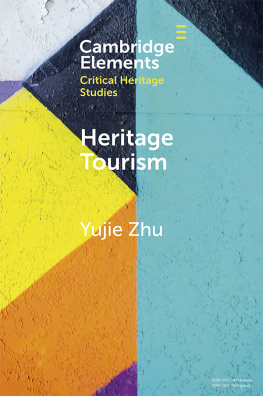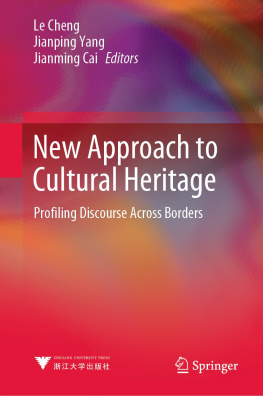Heritage under Socialism
New Perspectives on Central and Eastern European Studies
Published in association with the Herder Institute for Historical Research on East Central Europe, Marburg, Germany
Series Editors
Peter Haslinger, Director
Heidi Hein-Kircher, Head of the Department Academic Forum
Decades after the political changes that accompanied the fall of the Soviet Union, the history and cultures of Eastern Europe remain very important for understanding the challenges of today. With a special focus on the Baltic states, Poland, the Czech Republic, Slovakia, and Hungary, New Perspectives on Central and Eastern European Studies investigates the historical and social forces that have shaped the region, from ethnicity and religion to imperial legacies and national conflicts. Each volume in the series explores these and many other topics to contribute to a better understanding of contemporary Central and Eastern Europe.
Volume 2
Heritage under Socialism: Preservation in Eastern and Central Europe, 19451991
Edited by Eszter Gantner, Corinne Geering, and Paul Vickers
Volume 1
Rampart Nations: Bulwark Myths of East European Multiconfessional Societies in the Age of Nationalism
Edited by Liliya Berezhnaya and Heidi Hein-Kircher
Heritage under Socialism
Preservation in Eastern and Central Europe, 19451991

Edited by
Eszter Gantner, Corinne Geering, and Paul Vickers

First published in 2022 by
Berghahn Books
www.berghahnbooks.com
2022 Eszter Gantner, Corinne Geering, and Paul Vickers
All rights reserved. Except for the quotation of short passages for the purposes of criticism and review, no part of this book may be reproduced in any form or by any means, electronic or mechanical, including photocopying, recording, or any information storage and retrieval system now known or to be invented, without written permission of the publisher.
Library of Congress Cataloging-in-Publication Data
A C.I.P. cataloging record is available from the Library of Congress
Library of Congress Cataloging in Publication Control Number: 2021037698
British Library Cataloguing in Publication Data
A catalogue record for this book is available from the British Library
ISBN 978-1-80073-227-8 hardback
ISBN 978-1-80073-228-5 ebook
Contents
Corinne Geering and Paul Vickers
Corinne Geering
Julia Rttjer
Iryna Sklokina
Karin Hallas-Murula and Kaarel Truu
Eszter Gantner
Liliana Iuga
enk Pcha
Nele-Hendrikje Lehmann
Corinne Geering
Illustrations
Figures
.
.
.
.
.
.
.
.
.
.
Map
Acknowledgments
This book is based on research conducted in archives and libraries in at least ten countries, involving documents in as many languages. As editors, we are indebted to the knowledge and intellectual curiosity of our colleaguesthe contributorswho offer innovative perspectives on a broad spectrum of actors, sites, and regions connected to the history of heritage under socialism.
The idea for this volume emerged during conversations in 2016, as we realized that what was missing from existing scholarship was a history of heritage practices within socialist Eastern and Central Europe. We were interested in a transnational approach that would address specific aspects of heritage under socialism, while at the same time paying close attention to the global processes informing heritage discourses, policies, and practices in the region in the period from the end of World War II until the dissolution of the socialist bloc in 198991. While legacies of socialism have already received more attention from researchers in heritage studies in the last decade, and historical research on individual socialist countries has also flourished, the ways in which experts, authorities, and other actors in socialist statesincluding individual Soviet republicsengaged with preserving the tangible past has not been explored in detail. What makes this volumes contribution to scholarship particularly insightful and innovative is how it sheds light on the ways in which actors from the region interacted with each other and how they were involved in the development of international discourses that crossed the Iron Curtain. The historical processes between 1945 and 198991 shaped the specific conditions of heritage management that continue to have an effect in many postsocialist countries and in international organizations today.
This book emerged from a collaboration between several institutions in Germany: the Herder Institute for Historical Research on East Central Europe in Marburg and the International Graduate Centre for the Study of Culture (GCSC) at the Justus Liebig University, Giessen, with additional support by the Imre Kertsz Kolleg Jena and the Leibniz Research Alliance Historical Authenticity. We wish to thank our colleagues at these institutions for their encouragement, assistance, and inspiring conversations. We are also grateful to the anonymous reviewers for their insightful comments on an earlier draft of this volume. Finally, we would like to thank the team at Berghahn for their always supportive, patient, and constructive collaboration on this volume, in particular Chris Chappell, Mykelin Higham, and Elizabeth Martinez.
Our dear colleague Eszter Gantner is sadly no longer with us to see this project come to fruition. Eszter passed away in summer 2019 while we were revising the chapter drafts. Her colleagues at the Herder Institute, Peter Haslinger and Heidi Hein-Kircher, along with Eszters family, all helped in difficult circumstances to ensure her chapter could appear in this book. Eszters insight on the topic of heritage, as well as her interest in engaging in research conversations across disciplines, countries, and historical periods, have shaped this volume. We hope that by completing the work that we started together, a suitable testimony to her passion and enthusiasm has emerged.
Corinne Geering and Paul Vickers
Leipzig/Regensburg, January 2021
INTRODUCTION
Heritage under Socialism
Trajectories of Preserving the Tangible Past in Postwar Eastern and Central Europe

Corinne Geering and Paul Vickers
On the cover of this book, a small, seventeenth-century, Orthodox church building stands right next to a large, paneled skyscraper in the city center of Moscow. The size of the church pales in comparison with one of the twenty-four story buildings that were erected on the new Kalinin Prospekt, today known as Novyi Arbat, between 1964 and 1968 as part of Moscows urban development plan (). The arrangement of the two antithetic buildings may appear like a product of chance that saved a prerevolutionary, sacral building in the largest metropole of a state striving to build communism and promoting state atheism.
Next page






